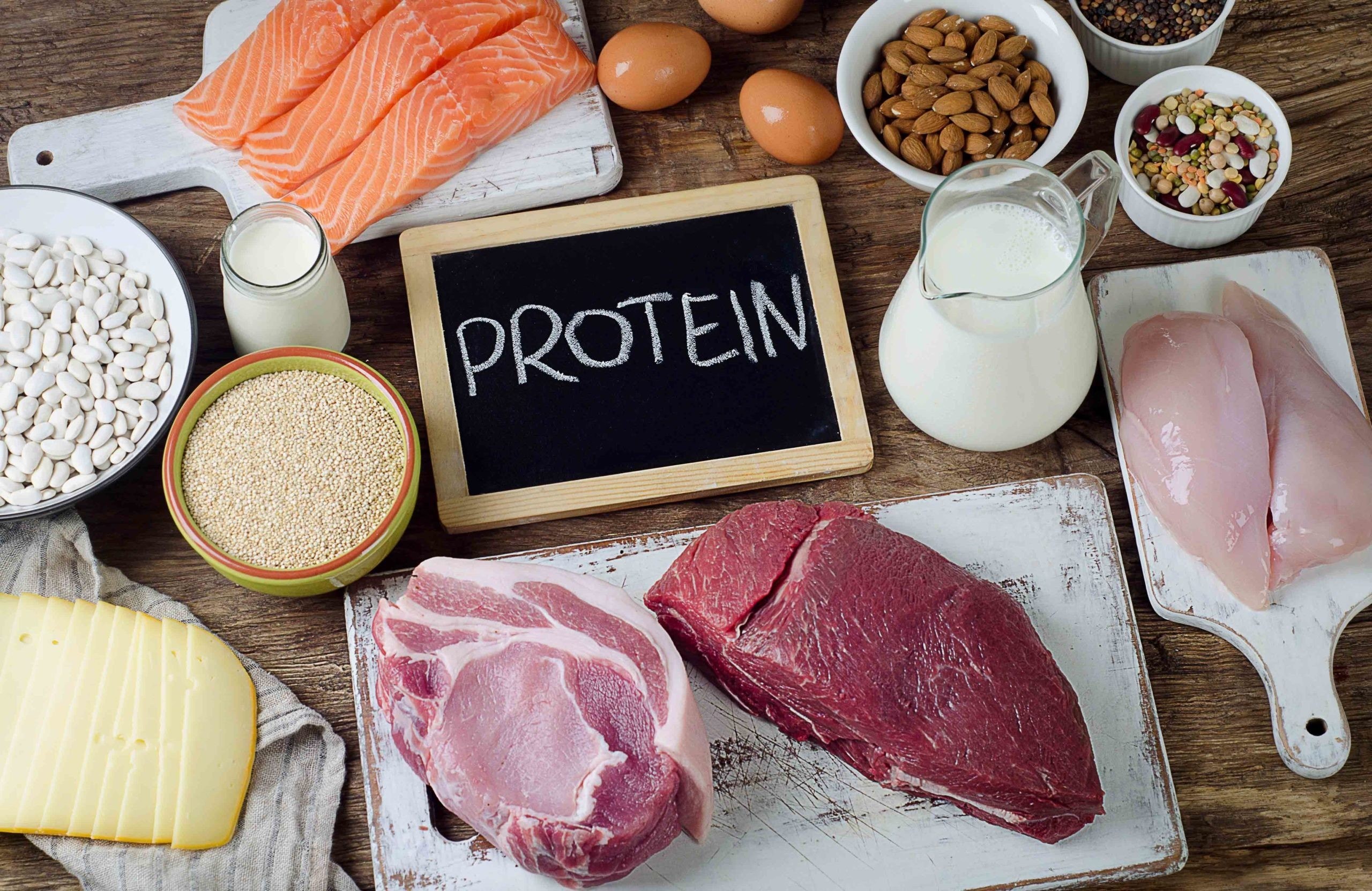Protein is an essential nutrient vital for the growth, repair, and proper function of your body’s cells. It plays a crucial role in numerous bodily processes, making it important to consume enough protein daily through your diet. The amount of protein you require varies based on factors such as your weight, gender, age, and overall health. Fortunately, meeting your protein needs is easily achievable by incorporating a variety of protein-rich foods into your daily meals. Protein sources are diverse, coming from both plant and animal origins.
 protein sources
protein sources
Understanding Protein and Amino Acids
Proteins are complex molecules constructed from smaller units known as amino acids. Imagine amino acids as building blocks, approximately 20 different types exist, and they link together in various combinations to form proteins. Your body utilizes these amino acids to synthesize new proteins, essential for building muscle, strengthening bones, and creating enzymes and hormones. Amino acids can also serve as a source of energy for the body.
Interestingly, your body can produce some amino acids on its own. These are called non-essential amino acids, and there are 11 of them. However, there are 9 amino acids that your body cannot produce; these are termed essential amino acids. To ensure your body functions optimally, you must obtain these essential amino acids through your diet by consuming protein-rich foods.
High-Quality Protein and Nutritional Value
The nutritional quality of a protein source is determined by the amount of essential amino acids it contains. Different foods offer varying quantities of these essential building blocks. Generally, animal-based products like chicken, beef, fish, and dairy are considered high-quality protein sources because they provide ample amounts of all essential amino acids.
Soy products, quinoa, and amaranth (a seed consumed in Asia and the Mediterranean) are also excellent sources of complete protein, containing all essential amino acids. Other plant-based proteins, such as beans, lentils, nuts, and whole grains, also contain all essential amino acids, though the levels of one or two may be lower compared to animal sources.
For individuals following vegetarian or vegan diets, it’s important to choose a diverse range of plant-based protein foods daily. Combining various plant proteins ensures a sufficient intake of all essential amino acids. A well-planned vegetarian or vegan diet, rich in varied foods, can easily meet your protein requirements. For instance, a meal combining cereals and legumes, like beans on toast, can provide a complete set of essential amino acids, similar to a typical meat-containing meal.
Top Food Sources High in Protein
Many delicious and readily available foods are excellent sources of protein. Here are some top examples to include in your diet:
- Lean Meats: Beef, lamb, veal, pork, and kangaroo are all lean meat options packed with protein.
- Poultry: Chicken, turkey, duck, emu, goose, and bush birds provide lean protein.
- Fish and Seafood: Fish, prawns, crab, lobster, mussels, oysters, scallops, and clams are not only high in protein but also rich in other essential nutrients.
- Eggs: Eggs are a versatile and complete protein source.
- Dairy Products: Milk, yogurt (especially Greek yogurt), and cheese (particularly cottage cheese) contribute significantly to your protein intake.
- Nuts and Seeds: Almonds, pine nuts, walnuts, macadamias, hazelnuts, cashews, pumpkin seeds, sesame seeds, and sunflower seeds, along with their butters, are convenient and protein-dense snacks and additions to meals.
- Legumes and Beans: All types of beans, lentils, chickpeas, split peas, and tofu are excellent plant-based protein sources.
While grains and cereal-based products also contain protein, they generally offer less protein compared to meat and meat alternatives.
Meeting Your Daily Protein Needs with High-Protein Foods
Following dietary guidelines is key to meeting your daily protein requirements. These guidelines often categorize foods into groups, each supplying essential nutrients. The primary food groups contributing to protein intake are:
- The ‘lean meat and poultry, fish, eggs, tofu, nuts and seeds, and legumes/beans’ group.
- The ‘milk, yogurt, cheese, and/or alternatives (mostly reduced fat)’ group.
Dietary recommendations typically suggest daily servings from each of these food groups as part of a balanced and healthy eating pattern. Since your body cannot store protein effectively and excretes excess, consuming smaller portions of protein-rich foods at each meal is the most efficient way to meet your daily needs.
Recommended Daily Servings of High-Protein Foods for Adults
| Person | Recommended Daily Servings of Lean Meat, Poultry, Fish, Eggs, Nuts, Seeds, and Legumes/Beans | Recommended Daily Servings of Milk, Yogurt, Cheese, and/or Alternatives (mostly reduced fat) |
|---|---|---|
| Men aged 19–50 years | 3 | 2 1/2 |
| Men aged 51–70 years | 2 1/2 | 2 1/2 |
| Men aged 70+ years | 2 1/2 | 3 1/2 |
| Women aged 19–50 years | 2 1/2 | 2 1/2 |
| Women aged 51–70 years | 2 | 4 |
| Women aged 70+ years | 2 | 4 |
| Pregnant women | 3 1/2 | 2 1/2 |
| Lactating women | 2 1/2 | 2 1/2 |
Understanding Serving Sizes of Protein-Rich Foods
A standard serving of ‘lean meat and poultry, fish, eggs, nuts and seeds, and legumes/beans’ is typically:
- 65g cooked lean meats (beef, lamb, veal, pork, goat, kangaroo) – approximately 90-100g raw.
- 80g cooked lean poultry (chicken, turkey) – 100g raw.
- 100g cooked fish fillet – about 115g raw or a small can of fish.
- 2 large eggs.
- 1 cup (150g) cooked dried beans, lentils, chickpeas, split peas, or canned beans (preferably with no added salt).
- 170g tofu.
- 30g nuts, seeds, peanut or almond butter, tahini, or other nut/seed paste (no added salt).
A serving of ‘milk, yogurt, cheese, and/or alternatives (mostly reduced fat)’ could include:
- 250ml (1 cup) fresh, UHT long-life, reconstituted powdered milk or buttermilk.
- 120ml (1/2 cup) evaporated milk.
- 200g (3/4 cup or 1 small carton) yogurt.
- 40g (2 slices) hard cheese like cheddar.
- 120g (1/2 cup) ricotta cheese.
Protein needs for children and teenagers vary as they grow. Consult dietary guidelines for specific recommendations for these age groups.
Simple Ways to Boost Your Protein Intake with Foods High in Protein
Looking to increase your protein consumption naturally? Here are practical tips incorporating foods high in protein:
- Peanut Butter Sandwich: Opt for natural peanut butter (or any nut butter) without added salt, sugar, or fillers for a protein-packed snack or meal.
- Cottage or Ricotta Cheese: These cheeses are high in protein and versatile. Add them to scrambled eggs, casseroles, mashed potatoes, pasta dishes, or enjoy them spread on toast.
- Nuts and Seeds in Salads and Meals: Enhance salads, vegetable dishes, and curries with nuts and seeds. Toasted pine nuts or flaked almonds add extra flavor and protein to green salads.
- Beans in Soups and Sauces: Incorporate beans into soups, casseroles, and pasta sauces. Adding a can of drained cannellini beans to vegetable soup or casseroles boosts protein content.
- Hummus and Veggie Sticks: Enjoy hummus with fresh vegetable sticks as a protein-rich snack or spread hummus on sandwiches for lunch.
- Greek Yogurt: Greek yogurt is a protein powerhouse. Add it to breakfast cereal, top pumpkin soup, or serve it as a dessert with fresh fruit.
- Eggs for Any Meal: Eggs are a quick and easy high-protein option, perfect on their own or mixed into various dishes.
Protein Deficiency: Recognizing the Signs
Protein deficiency, or inadequate protein intake, is relatively uncommon in regions with diverse food access. However, it can occur in specific populations, such as older adults or those on strict vegetarian or vegan diets without proper planning.
Symptoms of protein deficiency may include:
- Muscle wasting and shrinkage.
- Edema (fluid buildup, especially in feet and ankles).
- Anemia (reduced oxygen-carrying capacity of blood, often due to nutrient deficiencies).
- Slow growth in children.
Protein’s Role in Maintaining Muscle Mass as We Age
From around the age of 50, muscle mass naturally begins to decline, a condition known as sarcopenia, common in older individuals. This muscle loss can be exacerbated by chronic illness, poor diet, and inactivity.
Adequate daily protein intake is crucial for maintaining muscle mass and strength as you age. This helps preserve mobility and reduces the risk of falls and injuries. For older adults, consuming high-quality protein foods, like lean meats, is particularly important to effectively support muscle health.
Protein Supplements: Are They Necessary?
For most individuals, protein shakes, powders, and supplements are not essential for health. Surveys indicate that a vast majority of people obtain sufficient protein through their regular diet. Excess protein intake beyond your body’s needs is either excreted or stored as body fat.
The most effective way to meet your protein needs is by consuming a variety of protein-rich foods as part of a balanced diet, as recommended by dietary guidelines. If you are considering protein supplements, consulting with a healthcare professional is advisable.
Protein and Exercise: Fueling Your Body
Consuming a serving of high-quality protein, such as milk or yogurt, along with a carbohydrate-rich meal shortly after exercise is recommended. This practice helps maintain your body’s protein balance, even after moderate exercise like walking, especially for older adults.
For those engaging in vigorous exercise or aiming to build muscle mass, extra protein intake is generally not necessary. Muscle growth is primarily stimulated by exercise itself, not by excessive dietary protein. Studies show that individuals who weight train gain muscle mass at the same rate whether or not they supplement their diets with extra protein.
The Risks of Very High Protein Diets
Certain fad diets promote extremely high protein intakes, far exceeding recommended levels. Dietary guidelines provide sufficient protein for muscle building and repair, even for athletes. Excessively high protein diets can strain the kidneys and liver and may lead to calcium loss, increasing the risk of osteoporosis.
Seeking Professional Guidance
For personalized advice on your protein intake and dietary needs, consult a healthcare professional or a registered dietitian. They can provide tailored recommendations based on your individual health status and lifestyle.
